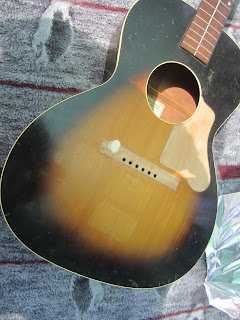Today was a hot day, 104 degrees in the forecast. This is great if I need to use heat on an instrument, but not great for me.
The instrument in question is a late 50's, early 60's Kamaka uke, with the most beautiful top I've seen on one of these. The problem is that the uke shrank when it left the moist Hawaiian climate and came to the dry mainland. One part did not shrink, the tailblock, which may have been too long to start with. (These were hastily made instruments. They are wonderful, but let's not pretend that these are master-built instrument.)
I already fixed the back, by running a credit card with sandpaper on it through the rack, reducing the tailblock to the correct size. Now for the front, which is better attached, has a big crack in the top, and nothing is moving.
 |
| That little gap at the top is what I'm working on. |
 |
| I really don't want to lose that little splinter of wood, if I can help it. |
 |
| And here is the crack, which follows the grain of the top. The bridge is all tilted and not down very well. |
 |
| I heated up a palette knife with my alcohol lamp. I also used a pipette to drip in a little water from time to time. |
 |
| After a bit of water and jsut a little prying, the bridge popped off. Notice how little of it actually made contact with the top. I'll have to clean off this glue and make sure that the contact is much better. If you look carefully, there is a spot of white haze under the right side of the bridge on the top of the uke. This was the result of a bit of steam coming off the palette knife when I put it into the water. I wiped that with alcohol and it went away. |
 |
| Sure enough, that splinter cam loose. Now what? |
 |
| I grabbed a sticky note, and stuck the splinter to it. |
 |
Fold it up, and stick it in the case. I can put it back when it is time to glue things back together.
|
After about a half-hour of careful prying and heating, I was able to loosen the top. I decided to stop and let things dry out before I went on.















































